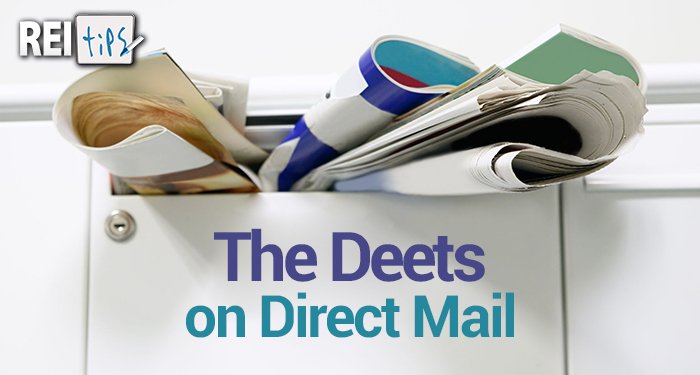“Direct mail is already the nation’s leading advertising medium because of its effectiveness in targeting, and because it is so measurable. This improvement only enhances its effectiveness.”
~Matt Spahn, Fortune 50 and start-up marketing and media executive
But the reality is: If done well, creating and sending direct mail pieces can be simple, extremely cost effective and beneficial to the growth of your business. You just have to spend the time necessary – up front – to make sure you’re doing it right.
Today, I want to share some insightful strategies to plan, create and mail postcards or letters that will bring you the best results (whether you’re looking for cash buyers, motivated sellers or both).
A major factor in this process is really dedicating time to the pre- and post-work involved, so I’ll cover that too. So, without further ado, let’s get into it!
Determining a Budget
This may seem like a no-brainer, but when it comes to direct mail (or any marketing technique), you need to determine a budget – and stick to it.
At first, I wouldn’t recommend spending boatloads of money (obviously), until you get your technique down. Direct mail marketing is truly an art – you can’t just throw a piece together willy-nilly and send it out to everyone and their brother. (Well, you could, but that would be pretty useless).
So, figure out how much (per month) you want to spend on direct mail. Be sure that you can commit to at least 12 months of spending this amount. You don’t want to blow $5 grand over the course of your first 3 months, and then realize you can’t afford to send anything else out for the rest of the year.
Whether it’s $200 or $2,000, choose your number wisely and commit to it.
Creating Your List(s)
This step, just like every other one in the direct mail process, deserves time and research. I would never recommend choosing a zip code and sending out a piece to every address in that area.
Would this be a super fast way of doing direct mail?
Yes.
But would it lead to property deals?
Unless you get randomly lucky, probably not.
Instead, you need to narrow down your recipient list to include only the people who have a possibility of being interested in your services.
So, as you get started, ask yourself these questions:
 Are you looking for buyers, sellers or a combo of both?
Are you looking for buyers, sellers or a combo of both? Do you want to target high-end, middle-class or low-income housing?
Do you want to target high-end, middle-class or low-income housing? Is your goal to find leads or to just get your name out there?
Is your goal to find leads or to just get your name out there?
Now, depending on who you’re targeting, you may be able to pull a lot of info from your county clerk of court website (where you can browse public records). Some lists, however, will require more work on your part. But overall, you will probably want to target one (or several) of these l, depending on your main goal:
 Tax delinquent
Tax delinquent Code violations
Code violations Equity
Equity Inheritance (check out USleadlist.com)
Inheritance (check out USleadlist.com) Evictions
Evictions Probate
Probate Notice of default
Notice of default Absentee owner
Absentee owner Pre-foreclosure
Pre-foreclosure Driving for dollars (custom list created by you)
Driving for dollars (custom list created by you)
You’ll probably have ideas of other lists you want to pursue, depending on the buyers or sellers that you’re targeting.
And, even with these lists in hand – it’s best to narrow down your recipient selection even more. Make sure the properties you’re targeting are located in the areas you’d actually be interested in buying or selling a property in.
Now, this might sound like a lot of work, and – let’s face it – it is. But, keep in mind that the more time-consuming a mailing list is to put together, the better your response ratio will be.
Think of it as studying for an exam. If you put 20 minutes into studying, you’re probably not going to do so well. But if you spend 2-3 hours studying, you’ll reap the benefits.
Time is money, my friends. Put enough time into crafting a specialized mailing list, and you will likely score more property deals in the long run.
Creating the Message
Now, if writing isn’t exactly your forte, you might feel a little uncomfortable with the idea of creating a message for your direct mail pieces. But, really, you don’t need to be a Shakespeare or a Stephen King.
You just need to think carefully about what you want to say on your postcard or letter.
Remember, your message needs to capture the reader’s attention within 1-2 seconds; otherwise, the recipient will immediately throw it away. So, your message needs to be impactful and to the point.
The “to the point” part is extremely important… no one’s going to waste time reading a novel. In as few words as possible, explain who you are, what you do and how your services can benefit them.
A couple of additional tips:
 Make the message about THEM – not you. Of course, you need to introduce yourself and why you’re contacting them. But, if you can make the message sound more like “I can help you” rather than “Me, me, me! Look at me!” people will pay attention.
Make the message about THEM – not you. Of course, you need to introduce yourself and why you’re contacting them. But, if you can make the message sound more like “I can help you” rather than “Me, me, me! Look at me!” people will pay attention. Offer to solve a problem. Depending on who you’re targeting with your direct mail pieces, make sure your message explains how you can solve their problem. For instance, if you’re targeting pre-foreclosure properties, you could use a message such as: “You can avoid foreclosure, and even walk away from your home with some money. Let me help you with the opportunity to start afresh.”
Offer to solve a problem. Depending on who you’re targeting with your direct mail pieces, make sure your message explains how you can solve their problem. For instance, if you’re targeting pre-foreclosure properties, you could use a message such as: “You can avoid foreclosure, and even walk away from your home with some money. Let me help you with the opportunity to start afresh.” Avoid vague messages. If you’re trying to appeal to everybody, you’ll appeal to nobody. Generic messages end up in the trash can. Just don’t go here.
Avoid vague messages. If you’re trying to appeal to everybody, you’ll appeal to nobody. Generic messages end up in the trash can. Just don’t go here.
Remember, keep it short, and make sure your contact info is prominently displayed. If you have a website, include it as well.
Making it Pretty
Now, this part is a little easier…
You don’t need to be a graphic designer; you just need to make sure your piece stands out. So, whether it’s adding color, having a handwritten message on the envelope or on the letter or postcard itself, using an oddly shaped postcard, or adding ANYTHING to make it seem more like a letter from a friend (rather than an advertisement) will work.
Whether you print the piece on your own, or order it from a print shop (probably a better option), just make sure the quality is high.
Determining Your Mailing Strategy
Even when you have a masterfully written, eye-catching, amazing piece of direct mail – and you have an awesome mailing list full of leads – you still shouldn’t send them out randomly.
To get the best results, make sure you have a mailing strategy. In this case, timing is everything. You want to make sure you stay top of mind with your leads, but you also don’t want to inundate them with constant mailings that drive them nuts.
Once you’ve determined a specific mailing list (say, probate, for example), mail to that group first. Then, follow up with them by sending another (different) piece 3 months later. All in all, you should send them a letter or postcard about 3-4 times per year.
So, an example schedule might look like this:
 January, April, July, October – mail to your probate leads
January, April, July, October – mail to your probate leads February, May, August, November – mail to your code violation leads
February, May, August, November – mail to your code violation leads March, June, September, December – mail to your tax delinquent leads
March, June, September, December – mail to your tax delinquent leads
Don’t send out a direct mail piece without having a long-term plan. Sending one random piece, and then dropping off the face of the earth, will not make a good impression on the leads you’re targeting.
No matter what type of schedule you decide on, stick with it!
One other important note to keep in mind: Depending on which area of the country you live in, you may want to take a break from mailings during the winter months. People tend to buy and sell houses much more frequently in March through October, and a message sent to them in the dead of winter might not make much of an impression.
On the other hand, you may want to send out seasonal pieces during those months (for instance, a “Happy Holidays” card in December). This increases your brand awareness – and your credibility – without making you seem like a “selling machine” who only cares about making money. Just something to think about.
Tracking Your Results
Now, this is one of the most important steps in the entire direct mail process. If you don’t track the results of your direct mail pieces, you will never know how effective they are – and if they are worth the money you’re spending.
So, I repeat: Always. Track. Your. Results.
The easiest way to do this is to include a unique email address or phone number on your postcard or letter. This way, when you receive a phone call to that number or an email to that email address, you will know that the person saw your direct mail piece. Make sure you track all of this info in a spreadsheet.
Or, if you want to get more sophisticated, you can have a unique URL on your postcard that brings people to a specific page on your website (a landing page with more info about you). Then, using Google Analytics, you’ll be able to easily see and track where the views of that webpage are coming from.
And, of course, when people contact you, keep track of your responses (for instance “left a voicemail on 6/21;” “sent an email on 7/15;” and so on. Follow up regularly, but don’t harass people. (Obviously, you know what to do, but I just wanted to throw that out there.)
An Underappreciated Marketing Method
With time, you will begin to see patterns of which mailing lists are working well for you and which aren’t. Depending on how many deals to get from these marketing pieces, you will also be able to determine your ROI.
Remember that knowing how to “do” direct mail well is involves a constant learning process. Something that works well this year might not be effective next year, for instance. Or a particular mailing list might bring you spectacular results one month, and no results 3 months later.
It’s all about trial and error…
As time goes on – and as you track your results – you will intuitively know the best approaches for your specific market, mailing list, and so on. And you’ll be able to apply this knowledge to create marketing campaigns that bring you the best results (aka motivated sellers and/or buyers).
Getting Started
What questions do you have about creating and sending an effective (and creative) direct mail piece? Let me know; I’d be happy to help!




